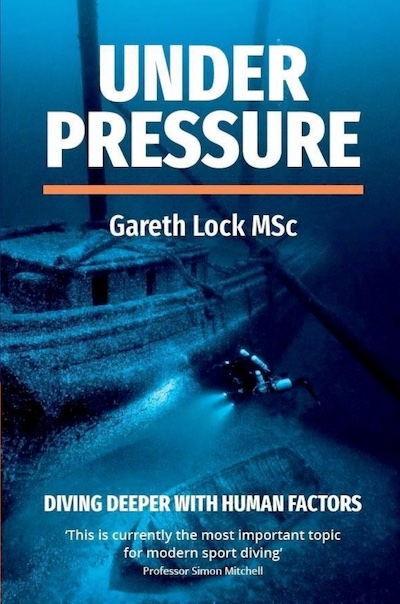Scuba Diving Book Reviews: Essential Reads for Skill, Safety, and Mindset
These reviews focus on how diving books change the way you plan, work with a team, and manage risk. You will not find marketing fluff here. Each title is judged on clarity, usefulness, and what it adds to real dives. Use the summaries and notes below to choose your next read with purpose.
Under Pressure

I picked up Gareth Lock's Under Pressure expecting a thoughtful read, but it ended up challenging how I think about dive safety entirely. It does not focus on gear or technique. It focuses on how we think, communicate, and make decisions. The central idea that human error is a symptom, not a root cause, really stuck with me, and it reframes incident analysis in a way that feels both fair and practical.
Lock draws a clear line between risk and uncertainty, which made me rethink how often divers lean too hard on numbers and confidence while ignoring the unknowns. He connects that to real diving through topics like psychological safety, situational awareness, and team communication, with examples that feel relevant rather than academic. The result is a grounded framework you can apply on your next brief and post dive review.
This is not a checklist book. It is a mindset shift with direct value for divers who want to work better with others, not just fine tune buoyancy. I would especially recommend it to instructors, divemasters, and anyone who wants to be more deliberate about decision making underwater.
The Fundamentals of Better Diving (2021)

This book is a broad introduction to the philosophy behind Global Underwater Explorers, covering everything from gear configuration to dive mindset. It is not overly technical, but it offers a solid overview of how GUE approaches diving as a system rather than a set of isolated skills. The emphasis on standardization and team clarity is consistent from pre dive checks to ascent procedures.
The part that stood out most was the GUE EDGE planning framework. It stands for Goal, Unified Team, Equipment, Exposure, Decompression strategies, Gas strategies, and Environmental concerns. That checklist alone was worth the read for me because it creates a common language and a predictable order that reduces confusion.
Seeing it used in real life before I knew the name helped it stick. During my drysuit class with Richard Tessell, the structured briefing created instant alignment. Later, reading the book confirmed that process and gave me a template I could repeat with other teams.
The Six Skills and Other Discussions

Even though this book was published in 2011, the concepts still hold up. It is subtitled Creative Solutions for Technical Divers, but most of the content is useful to recreational divers as well. I would estimate that about ninety percent applies directly, even if the language and examples lean technical.
One of the most valuable takeaways for me was a proper method for calculating weighting. That section alone was worth the read because weighting is often misunderstood or oversimplified in recreational training. The book also includes a deeper look at decompression theory, which helps reinforce a more careful approach to planning even if you never plan to do staged decompression.
The only caution I would add is that the author sometimes uses SAC and RMV interchangeably. If you know the difference, it is easy to adjust as you read. For divers who want to think more critically and creatively about improving their diving, the book remains a solid choice.
Technical Diving an Introduction

Despite the title, this book has a lot to offer recreational divers. While it touches on rebreathers and deep exploration, much of the material is directly relevant to anyone who wants more control and awareness. Think of it as a thoughtful expansion on topics that entry level courses only introduce in passing.
It covers gear configuration, buoyancy, trim, finning, common drills, and the foundations of decompression, all in more depth than typical open water materials. After taking the GUE Fundamentals class, I noticed how closely the course content aligns with what Powell describes. The overlap is significant, and both emphasize precision, discipline, and team based planning.
I recommend this book to divers at any level who want to understand their diving better. Whether you are getting serious about personal skills or thinking about advancing into more complex dives, this is a strong foundation that will make later training easier to absorb.
Deco for Divers

Most recreational divers will find little reason to read the entire book, and that is fair to say up front. It is not a light read, and it is not meant to be. If you want to understand the why behind decompression rather than only follow a computer, this is one of the best resources available and it rewards careful study.
The coverage spans the history of models, the physics of pressure and gas behavior, and topics such as half times, compartments, m values, ascent rates, and why the idea of a no decompression dive is more myth than reality. The author also explains the rise and decline of deep stops and the limits of modern bubble models in plain language that a diligent reader can follow.
There is a detailed breakdown of DCS, AGE, and DCI with how to recognize and respond to symptoms. You will find explanations of PFOs, predisposing factors, and a walk through of the five minute neurological exam. The closing chapters discuss saturation diving, Nitrox, and the now cost prohibitive realm of mixed gas diving. If you are heading toward technical training, this book is a valuable reference to keep on your shelf.